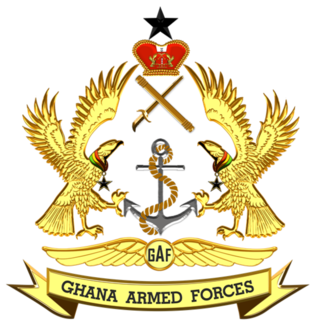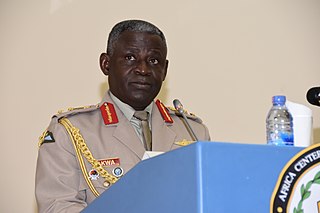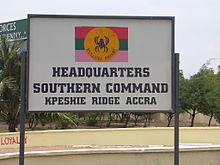
The Ghana Armed Forces (GAF) is the unified armed force of Ghana, consisting of the Army (GA), Navy (GN), and Ghana Air Force.

The Canadian Army is the command responsible for the operational readiness of the conventional ground forces of the Canadian Armed Forces. It maintains regular forces units at bases across Canada, and is also responsible for the Army Reserve, the largest component of the Primary Reserve. The Army is headed by the concurrently held Commander of the Canadian Army and Chief of the Army Staff, who is subordinate to the Chief of the Defence Staff. The Army is also supported by 3,000 civilian employees from the civil service.

The King's African Rifles (KAR) was a British Colonial Auxiliary Forces regiment raised from Britain's East African colonies in 1902. It primarily carried out internal security duties within these colonies along with military service elsewhere during the world wars and other conflicts, such as the Malayan Emergency and the Mau Mau uprising. The regiment's enlisted soldiers were drawn from the native Africans, while most officers were seconded from the British Army. During the 1960s, as part of the decolonisation of Africa, more African officers were commissioned into the regiment before it was gradually disbanded. KAR battalions would go on to form the core of newly established armed forces throughout East Africa.
The South African 2nd Infantry Division was an infantry division of the army of the Union of South Africa during World War II. The division was formed on 23 October 1940 and served in the Western Desert Campaign and was captured by German and Italian forces at Tobruk on 21 June 1942. The remaining brigade was re-allocated to the South African 1st Infantry Division.

The Ghana Air Force (GHF) is the aerial warfare organizational military branch of the Ghanaian Armed Forces (GAF). The GHF, along with the Ghanaian army (GA) and Ghanaian navy (GN), make up the Ghanaian Armed Forces (GAF), which are controlled by the Ghanaian Ministry of Defence (MoD).

The Canadian Grenadier Guards (CGG) is a reserve infantry regiment in the 34 Canadian Brigade Group, 2nd Canadian Division, of the Canadian Army. The regiment is the oldest and second-most-senior infantry regiment in the Primary Reserve of the Canadian Army. Located in Montreal, its main role is the provision of combat-ready light infantry troops in support of Canadian regular infantry. It is a Household Foot Guard regiment and also provides soldiers for public ceremonial duties, performing similar ceremonial duties as the Guards regiments of the British Army. This primarily entails mounting the guard at Government House, the Governor General's residence, and performing the "Changing the Guard" ceremony on Parliament Hill in Ottawa, a task it shares with Canada's senior Household Foot Guard regiment, the Governor General's Foot Guards of Ottawa. The Canadian Grenadier Guards is an allied regiment to the British Grenadier Guards.

John Ebenezer Samuel de Graft-Hayford (1912–2002) was Ghana's first Ghanaian Chief of Air Staff. He became the first indigenous Air Force Commander in Ghana and Black Sub-Saharan Africa. He was also acting Chief of Defence Staff (CDS) for a brief period in 1962.

Lieutenant-General Emmanuel Kwasi Kotoka Born was a Ghanaian military officer who was a member of the ruling National Liberation Council which came to power in Ghana in a military coup d'état on 24 February 1966. This overthrew the government of Dr. Kwame Nkrumah, the first president of the republic.

The Chief of the Defence Staff (CDS) is the professional head of the Ghana Armed Forces. He is thus responsible for the administration and the operational control and command of the Ghana military. The CDS is a member of the Armed Forces Council. This council advice the President of Ghana on matters of policy relating to defence and also regulates the administration of the Armed Forces. It also advises the President on the promotion of all officers above the rank of Lieutenant-Colonel or its equivalent.

The Ghana Navy (GN) is the naval warfare organizational military branch of the Ghanaian Armed Forces (GAF). The Ghanaian Navy, along with the Ghanaian Army (GA) and Ghanaian Air Force (GHF), make up the Ghanaian Armed Forces (GAF) which are controlled by the Ghanaian Ministry of Defence (MoD).

Rear Admiral David Animle Hansen was a Ghanaian naval officer who served as Chairman of the Greater Accra Regional Administrative Committee from 1966 to 1967 in the National Liberation Council regime and as Commander of the Ghana Navy from 1962 to 1967. He was the first Ghanaian to be appointed head of the Ghana Navy. Hansen was also the founding director of the National Vocational Training Institute, and held this office from 1970 to 1980.
Major Courage Emmanuel Kobla Quashigah was a Ghanaian soldier and politician. He held many prominent positions in the Ghana Armed Forces and was a Minister of State for Agriculture and later Health in the NPP government of John Kufuor between 2001 and 2009.
This article provides formation lists of the Polish People's Army order of battle at various points in history between 1943 and 1989.
Army 2020 was the name given to the restructuring of the British Army in the early and mid-2010s, in light of the Strategic Defence and Security Review 2010. The plan, as its name suggested, was intended to be completed by 2020, though most of its reorganisations were completed by the middle of the decade. It was succeeded by Army 2020 Refine, a series of new changes and refinements of Army 2020's restructuring, conducted in light of the Strategic Defence and Security Review 2015.

The page contains the current structure of the British Army. The British Army is currently being reorganised to the Future Soldier structure.

Lieutenant General Obed Boamah Akwa is a retired Ghanaian military officer who served as the Chief of the Defence Staff of the Ghana Armed Forces from February 2017 to February 2021. Prior to his appointment, he was the Chief of Army Staff of the Ghana Armed Forces.
The following is a hierarchical outline for the structure of the British Army in 1989. The most authoritative source for this type of information available is Ministry of Defence, Master Order of Battle, and United Kingdom Land Forces, HQ UKLF, UKLF ORBAT Review Action Plan, HQ UKLF, 1990.
Brigadier Joseph Edward Michel (1917-1961) was a Ghanaian soldier. He was one of the early commissioned officers in the Ghana Army.
Michel Camp is the base of the First Battalion of Infantry of the Ghana Army. It is located at Tema in the Greater Accra Region of Ghana. The First Battalion together with the Second and Fifth Battalions of Infantry make up the Southern Command of the Ghana Army.
Lieutenant Colonel Chemogo Dodzil Benni is a Ghanaian soldier, politician and diplomat. He was a member of the National Redemption Council (NRC) military government which ruled Ghana between January 1972 and October 1975.





























